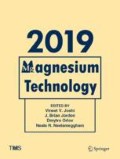Abstract
Mg–Zn solid solutions have been reported to show 14–21% tensile elongation after rolling and annealing, but their textures exhibit strong basal texture similar to pure Mg. This phenomenon contrasts with the case in Mg–Y solid solutions showing good RT ductility and weakened basal textures. To reveal the mechanism of the good ductility and strong basal texture of Mg–Zn solid solutions at RT, we investigated the effect of Zn on Mg alloys using atomistic simulations. The simulations show that Zn can activate <c + a> slip by reducing critical resolved shear stress anisotropy among slip systems, thereby improving ductility . It is also found that grain boundary segregation tendency of Zn is low. The grain boundary segregation is known to affect twinning and recrystallization which can modify the texture evolution process. From the low grain boundary segregation of Zn, Mg–Zn alloys are expected to yield a texture similar to that of pure Mg.
Access this chapter
Tax calculation will be finalised at checkout
Purchases are for personal use only
References
Sandlöbes S, Zaefferer S, Schestakow I, Yi S, Gonzalez-Martinez R (2011) On the role of non-basal deformation mechanisms for the ductility of Mg and Mg-Y alloys. Acta Mater. 59:429–439
Agnew SR, Duygulu Ö (2005) Plastic anisotropy and the role of non-basal slip in magnesium alloy AZ31B. Int. J. Plast. 21:1161–1193
McDonald JC (1940) Tensile properties of rolled magnesium alloys, I-binary alloys with aluminum, antimony, bismuth, cadmium, copper, lead, nickel, silver, thallium, tin and zinc. Trans. Am. Inst. Mining, Metall. Pet. Eng. 137:430
Stanford N, Barnett MR (2009) Effect of particles on the formation of deformation twins in a magnesium-based alloy. Mater. Sci. Eng. A 516:226–234
Lee JY, Yun YS, Kim WT, Kim DH (2014) Twinning and texture evolution in binary Mg-Ca and Mg-Zn alloys. Met. Mater. Int. 20:885–891
Zeng ZR, Bian MZ, Xu SW, Davies CHJ, Birbilis N, Nie JF (2015) Texture evolution during cold rolling of dilute Mg alloys. Scr. Mater. 108:6–10
Zeng ZR, Zhu YM, Xu SW, Bian MZ, Davies CHJ, Birbilis N, Nie JF (2016) Texture evolution during static recrystallization of cold-rolled magnesium alloys. Acta Mater. 105, 479–494
Boehlert CJ, Knittel K (2006) The microstructure, tensile properties, and creep behavior of Mg-Zn alloys containing 0-4.4 wt.% Zn, Mater. Sci. Eng. A. 417:315–321
Chino YT, Ueda T, Otomatsu Y, Sassa K, Huang X, Suzuki K, Mabuchi M (2011) Effects of Ca on Tensile Properties and Stretch Formability at Room Temperature in Mg-Zn and Mg-Al Alloys. Mater. Trans. 52:1477–1482
Stanford N, Barnett MR (2013) Solute strengthening of prismatic slip, basal slip and {10-12} twinning in Mg and Mg-Zn binary alloys. Int. J. Plast. 47:165–181
Shi BQ, Chen RS, Ke W (2013) Effects of yttrium and zinc on the texture, microstructure and tensile properties of hot-rolled magnesium plates. Mater. Sci. Eng. A 560:62–70
Zeng ZR, Bian MZ, Xu SW, Davies CHJ, Birbilis N, Nie JF (2016) Effects of dilute additions of Zn and Ca on ductility of magnesium alloy sheet. Mater. Sci. Eng. A 674:459–471
Lee JY, Yun YS, Kim WT, Kim DH (2014) Twinning and texture evolution in binary Mg-Ca and Mg-Zn alloys. Met. Mater. Int. 20:885–891
Yuasa M, Miyazawa N, Hayashi M, Mabuchi M, Chino Y (2015) Effects of group II elements on the cold stretch formability of Mg-Zn alloys. Acta Mater. 83:294–303
Somekawa H, Kinoshita A, Kato A (2018) Effect of alloying elements on room temperature stretch formability in Mg alloys. Mater. Sci. Eng. A 732:21–28
Jang HS, Lee BJ (2019) Effects of Zn on < c+a > slip and grain boundary segregation of Mg alloys. Scr. Mater. 160:39–43
Jena AK, Chaturvedi MC (1992) Phase transformations in materials. Prentice-Hall, New Jersey
Nie JF, Zhu YM, Liu JZ, Fang XY (2013) Periodic Segregation of Solute Atoms in Fully Coherent Twin Boundaries. Science 340:957–960
Pekguleryuz, MO, Kainer KU, Kaya AA (2013) Fundamentals of magnesium alloy metallurgy. Woodhead Publishing
Frenkel D, Smit B (1996) Molecular Dynamics Simulations. Academic Press, New York
Kim KH, Jeon JB, Kim NJ, Lee BJ (2015) Role of yttrium in activation of < c+a > slip in magnesium: An atomistic approach. Scr. Mater. 108:104–108
Kim KH, Hwang JH, Jang HS, Jeon JB, Kim NJ, Lee BJ (2018) Dislocation binding as an origin for the improvement of room temperature ductility in Mg alloys. Mater. Sci. Eng. A 715:266–275
Hadorn JP, Hantzsche K, Yi S, Bohlen J, Letzig D, Wollmershauser JA, Agnew SR (2012) Role of solute in the texture modification during hot deformation of Mg-rare earth alloys. Metall. Mater. Trans. A Phys. Metall. Mater. Sci. 43:1347–1362
Robson JD, Haigh SJ, Davis B, Griffiths D (2015) Grain Boundary Segregation of Rare-Earth Elements in Magnesium Alloys. Metall. Mater. Trans. A 47:522–530
Acknowledgements
This research was supported by Basic Science Research Program through the National Research Foundation of Korea (NRF) funded by the Ministry of Science, ICT and Future Planning (2016R1A2B4006680).
Author information
Authors and Affiliations
Corresponding author
Editor information
Editors and Affiliations
Rights and permissions
Copyright information
© 2019 The Minerals, Metals & Materials Society
About this paper
Cite this paper
Jang, HS., Lee, BJ. (2019). Dislocation Behavior and Grain Boundary Segregation of Mg–Zn Alloys. In: Joshi, V., Jordon, J., Orlov, D., Neelameggham, N. (eds) Magnesium Technology 2019. The Minerals, Metals & Materials Series. Springer, Cham. https://doi.org/10.1007/978-3-030-05789-3_32
Download citation
DOI: https://doi.org/10.1007/978-3-030-05789-3_32
Published:
Publisher Name: Springer, Cham
Print ISBN: 978-3-030-05788-6
Online ISBN: 978-3-030-05789-3
eBook Packages: Chemistry and Materials ScienceChemistry and Material Science (R0)

